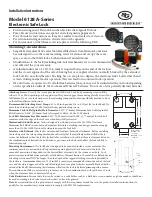
A. Make sure the lock bolt doesn’t bind against the safe’s boltwork. The top photo shows binding of the edge of
the cutout in the safe’s blocking bar, even though the boltwork is fully thrown to the locked position. In the
bottom photo, the binding has been relieved by removing a small amount of material from the side of the
blocking bar cutout. It is important that there is clearance on all sides of the lock’s bolt when the boltwork is
in the fully locked position. Binding will impair the lock’s performance. Any necessary modifications should
be made to the boltwork, not the lock.
B. If your safe incorporates a relock device, you will need to attach the plate that normally holds it in check to
the lock body. This is usually done at the lock’s cover screw locations. Remove the cover screws. DO NOT
REMOVE THE LOCK COVER, as this will void the product warranty. Typically, the cover screws will be
replaced with slightly longer 8-32 machine screws. Your replacement screws must engage the threaded holes
in the lock body by at least four threads. Relock device designs vary from safe to safe. You must make sure
the replacement cover screws hold the lock cover firmly against the lock body, and that the relock device
plate holds the device securely in check. Otherwise, there is risk of a lockout. After the plate is installed, once
again check to make sure wires and cables are secured so that they will not come into contact with moving
boltwork or anything else that can damage them.
Lock installation Considerations
Incorrrect
Corrrect
3























